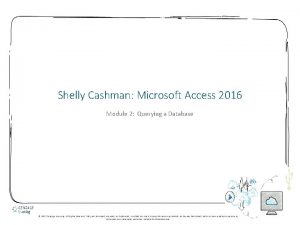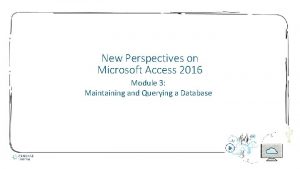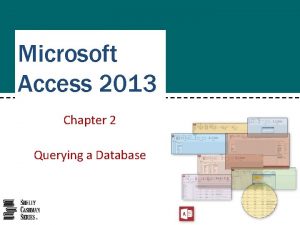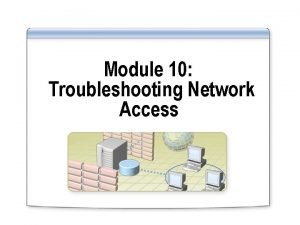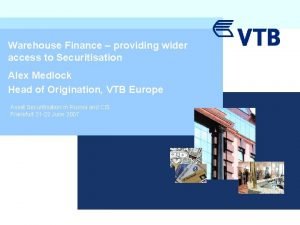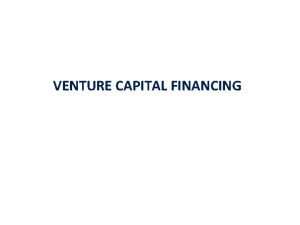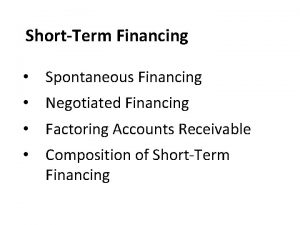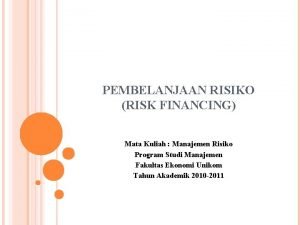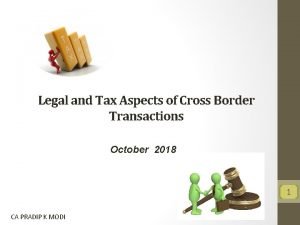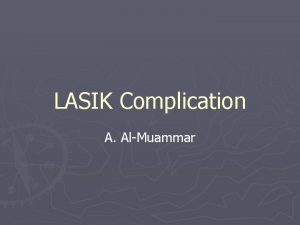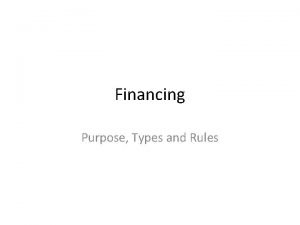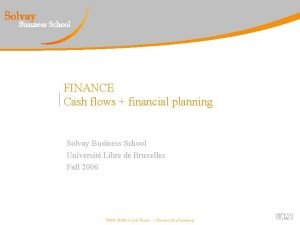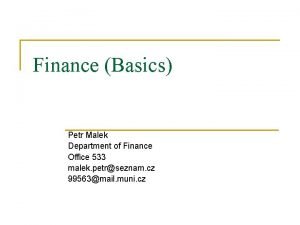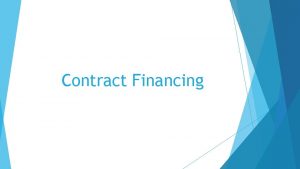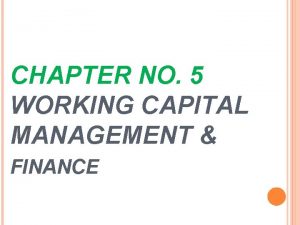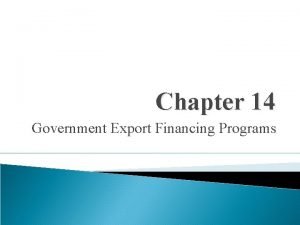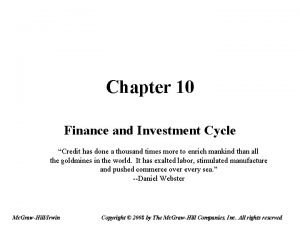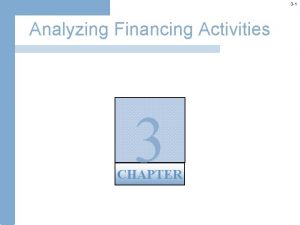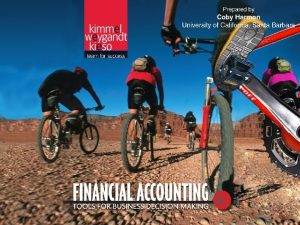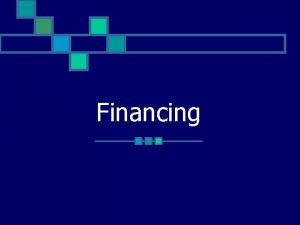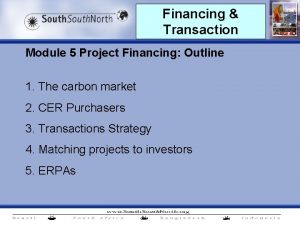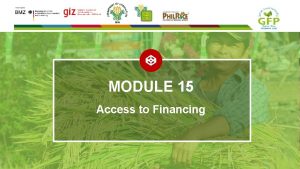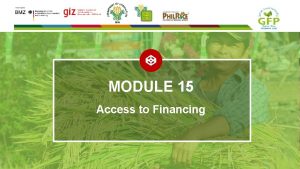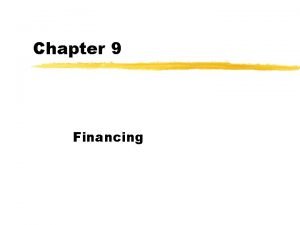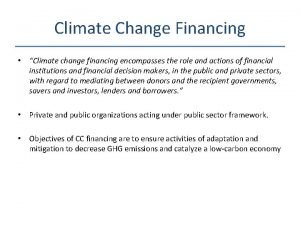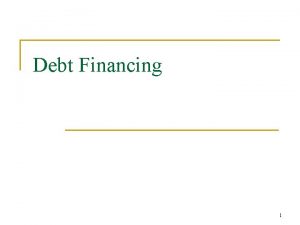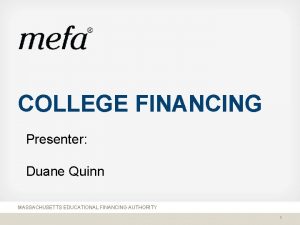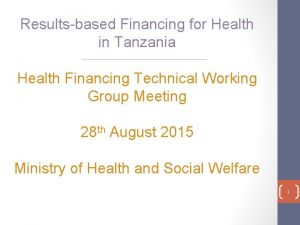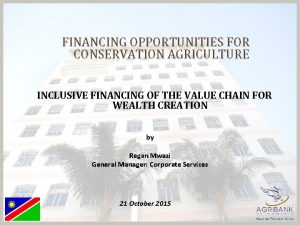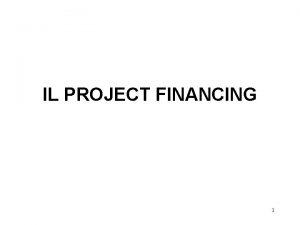MODULE 15 Access to Financing 30 11 2020
































- Slides: 32

MODULE 15 Access to Financing 30. 11. 2020 1

Learning Objectives Understand the basics of microfinance 30. 11. 2020 Appreciate the Food Staple Sufficiency Program – Credit Component Recognize existing credit programs for rice production Appreciate the unique features of DA-LBP Sikat Saka Program (SSP) 2

Outcomes By participating in this training you will be able to: Understand the basics of microfinance; Appreciate the Food Staples Sufficiency Program – Credit Component; Recognize existing credit programs for Rice Production; and Appreciate the unique features of DA-LBP Sikat Saka Program (SSP) 30. 11. 2020 3

Structure • Lesson 1. Microfinance • Lesson 2. Sources of Capital and Support System for Farmers – Existing DA Credit/Loan Programs and The DA-LBP Sikat Saka Program (SSP) 30. 11. 2020 4

Lesson 1: Microfinance Learning Objectives: • Learn the basics of microfinance • Identify sources of microfinance 30. 11. 2020 5

Microfinance 30. 11. 2020 6

What is Microfinance – BSP, etc. (2014)… … viable and sustainable provision of loans, savings, insurance, remittance, payment, investment, etc. services to poor households using simplified, non-traditional and innovative financial technologies. 30. 11. 2020 7

Three types of sources of microfinance • Formal institutions – i. e. , rural banks and cooperatives • Semiformal institutions – i. e. , non-government organizations • Informal sources – i. e. , money lenders, shopkeepers, family, friends, neighbors 30. 11. 2020 8

Lesson 2: Sources of Capital and Support System for Farmers – Existing DA Credit/Loan Programs and The DA-LBP Sikat Saka Program (SSP) Learning Objectives • Create awareness on Food Staples Sufficiency Program – Credit Component • Identify existing credit/loan programs for rice production • Promote appreciation of the Credit Programs of the Government 30. 11. 2020 9

Outcome At the end of this training, participants will be able to: Describe the credit component of the Food Staples Sufficiency Program; Identify existing credit programs of the government for rice production; Distinguish the unique features of the DA-LPB Sikat Saka Program (SSP) Outline the documentary requirements for availing of Sikat Saka loan; and Prepare their own farm plan and budget 30. 11. 2020 10

Structure • Food Staples Sufficiency Program – Credit Component (FSSP-CC) • Agriculture and Fisheries Financing Program • Agrarian Production Credit Program • Agri-Microfinance Program • Calamity Assistance Program • DA-LBP Sikat Saka Program 30. 11. 2020 11

Short Story g about the in th y n a y a s e h Did es me? w o e h 0. 0 0 0 , 0 0 Php 2 30. 11. 2020 12

Food Staples Sufficiency Program – Credit Component (FSSP-CC) 30. 11. 2020 13

Two components of FSSP-CC • Current Credit Programs (Agriculture and Fisheries Financing Program (AFFP), Agrarian Production Credit Program (APCP), Agri-Microfinance Program and Calamity Assistance Program from conduit organizations with added support services (irrigation, training, marketing, etc. ) • Department of Agriculture – Land. Bank of the Philippines (DALBP) Sikat Saka Program for individual farmers who are members of Irrigators Associations (IAs) and Small Water Impounding System Association (SWISA) in good standing that are ready to strengthen their credit worthiness. 30. 11. 2020 14

Agricultural Credit, Guarantee, and Insurance System PRIVATE SECTOR -BANKS -COOPS -MFIs LOANS/ ACCESS TO CREDIT GOVERNMENT CREDIT GUARANTEE (AGFP) CREDIT PROGRAMS - AGRICULTURE & FISHERIES FINANCING PROGRAM (AFFP) - AGRARIAN PRODUCTION CREDIT PROGRAM (APCP) - AGRI-MICROFINANCE PROGRAM - CALAMITY ASSISTANCE PROGRAM - SIKAT SAKA PROGRAM RA 10000 PHILIPPINE CROP INSURANCE CORP. (PCIC) FARMERS & FISHERFOLK 30. 11. 2020 15

1. Agriculture and Fisheries Financing Program (AFFP) Description Eligible Borrowers - Landbank extends loans directly to eligible small farmers & fisherfolk - Non-ARB small farmers and fisherfolk registered in the RSBSA - PCFC extends wholesale loans to accredited Microfinance Institutions (MFIs) – rural banks, coops. , NGOs – that in turn relend to eligible small farmers & fisherfolk - Non-ARB small farmers and fisherfolk registered in the RSBSA or members of their household 30. 11. 2020 Loan Purpose Interest Rate - Production of priority - 15% per annum agri-fishery (through Land. Bank) commodities - Prevailing interest - Agri-microfinance rates (through and agri-fishery PCFC’s accredited loans MFIs) 16

2. Agrarian Production Credit Program (APCP) Description Eligible Borrowers Loan Purpose Interest Rate - Caters to - Agrarian Reform - Crop Production. - 8. 5 % per annum Agrarian Reform Beneficiaries Long-term for short –term Beneficiaries (ARBs) or ARB agricultural loan (ARBs) whose household production, agrirespective members enterprise and/or - 9. 5 % per annum organizations are (through livelihood projects for term loan not yet eligible to ARBOs/FOs/POs avail themselves and other of loans under Conduits) the existing regular programs of the Land. Bank 30. 11. 2020 17

3. Agro-Microfinance Program (AMP) Eligible Description Borrowers - Adopts a - Spouses, “Wholesalerhousehold Retailer” scheme heads or adult in the provision of working credit by the members of PCFC to its small farming accredited MFIs and fishing for relending to households individual borrowers 30. 11. 2020 Loan Purpose - Any or a combination of farm, off-farm, and non-farm income generating activities Interest Rate - Prevailing market rate (24 % 36 % per annum) 18

4. Calamity Assistance Program (CAP) Eligible Description Borrowers - Provides funding - Small farmers support to existing and fisherfolk DA/ACPC and/or their partners/conduits for household extending calamity loan members who assistance to small are borrowers farming and fishing under the families in typhoonexisting affected areas for the programs of rehabilitation of their DA/ACPC livelihood activities 30. 11. 2020 Loan Interest Rate Purpose - Agricultural - Zero percent production (0 %) per loans and annum agricultural microfinanc e loans 19

5. DA – LBP Sikat Saka Program Description - Adopts both “Direct Lending” and “Wholesaler-Retailer” schemes in the provision of credit to small palay farmers using the Land Bank’s deposit (ATM) account and auto-debit services in facilitating loan releases and payments 30. 11. 2020 Eligible Borrowers - Palay farmers endorsed by Irrigator’s Associations (IAs) in the program’s priority areas Loan Purpose - Palay production Interest Rate - 15% per annum for the first two cycles and for succeeding cycles, the rate goes down by 1% per cycle 20

DA-LBP Sikat Saka Program 30. 11. 2020 21

Program Objectives • To provide credit assistance to palay farmers in a timely manner and at an affordable cost • To improve the viability and sustainability of palay production • To expand the credit outreach and increase rice production for food sufficiency. 30. 11. 2020 22

Program features • Accessibility • Affordability • Timeliness • Face and Credit Worthiness • Management Takeover Agreement 30. 11. 2020 23

Integrated support services of the Sikat Saka • Marketing Component (National Food Authority and National Agribusiness Corporation) • NFA will cover the procurement process. • NABCOR’s marketing component will be limited in regions where their facility is accessible like Region 6. • Rice Crop Insurance by Philippine Crop Insurance Corporation (PCIC) 30. 11. 2020 24

30. 11. 2020 25

Farm Plan and Budget Activity 1. Farm Plan and Budget 30. 11. 2020 26

Objective Duration Number of Participants Materials To guide farmers in preparing their own farm plan and budget. 25 minutes 30 people Manila Paper 5 Pentel Pens 5 Calculators Timer Process 1. 2. 3. 4. 5. Debrief and Conclusion 30. 11. 2020 Ask participants to count off from 1 to 5 Ask all the 1 s to group together, all the 2 s to group together, etc. Give each group manila paper, a pentel pen and a calculator. Ask each group to assign 1 secretary and 1 reporter. Ask each group to prepare their own farm plan and budget for 1 hectare riceland. (This should reflect prevailing farm activities and corresponding budget allocations in their communities. The template should be used for reference. ) 6. After 20 minutes, ask each group to report the results of their discussion. Debrief and summarize. Be sure to clarify and correct 27 misunderstandings that may arise.

Facilitate the provision of credit to ARBs and their household, and other small farmers and fishers to support crop, livestock and fishery production, and other livelihood projects. 30. 11. 2020 SIKAT SAKA • Rice-farmers in 45 provinces; IAmembers • Corn farmers in 9 provinces; members of FOs APCP ARBOs and FOs with ARB members AFFP Non-ARB, RSBSAregistered small farmers and fishers 28

Regular Lending Window Coop-member SFF Rice Farmers AFFP 30. 11. 2020 Non-ARB SFF, RSBSA-registered, with projects other than rice and corn In SSP provinces (IA/SWISA member, ARB or non-ARB) In the 45 top-rice producing provinces Sikat Saka ARBs, with projects other than rice and corn production in Sikat Saka APCP provinces 29

Tic-Tac-Toe Game Activity 2 Tic-Tac-Toe 30. 11. 2020 30

Objective Duration Number of Participants Materials Process Debrief and 30. 11. 2020 Conclusion To evaluate what the farmers have learned after the training. 20 minutes 30 people Large Manila Paper 1. Divide the participants into 4 groups. 2. Group 1 and 2 will compete with one another. The same will be done for Group 3 and 4. 3. Instruct the competing teams to stand in front of the large manila paper drawn with a Tic-Tac-Toe grid. 4. Questions about the lessons will be asked. The first team to answer correctly will have one member to stand on one square. If the same team answers the next question correctly, another member will stand on an adjoining square and so on. 5. The team which forms a straight line with three of its members on the grid by answering the questions correctly wins the game. (Note: The other group may block its opponent’s moves by answering correctly and having one member to stand on a square. ) Debrief and summarize. Be sure to clarify and correct misunderstandings that may 31 arise.

Thank you!!! 30. 11. 2020 32
 C device module module 1
C device module module 1 Access module 2: querying a database
Access module 2: querying a database Access module 3 maintaining a database
Access module 3 maintaining a database Access module 2 querying a database
Access module 2 querying a database Shared computing cluster
Shared computing cluster Network access module
Network access module Terminal access controller access-control system
Terminal access controller access-control system Terminal access controller access-control system
Terminal access controller access-control system Scotiabank yield more financing
Scotiabank yield more financing Long term financing
Long term financing Warehouse financing securitization
Warehouse financing securitization Methods of venture capital financing
Methods of venture capital financing Philippe thiel
Philippe thiel Eca financing
Eca financing What is spontaneous financing
What is spontaneous financing Contoh risk financing transfer
Contoh risk financing transfer This veterans basic entitlement is $36 000*
This veterans basic entitlement is $36 000* Club champion financing
Club champion financing Cross boarder transactions
Cross boarder transactions Lasik financing colton
Lasik financing colton Ibm client center
Ibm client center Robert fugard
Robert fugard Project financing codice appalti
Project financing codice appalti Purpose of financing
Purpose of financing Financing outflow
Financing outflow Direct financing
Direct financing Finance contract
Finance contract Working capital cycle
Working capital cycle Intermediate accounting leases
Intermediate accounting leases Export financing
Export financing Financing and investing cycle
Financing and investing cycle Analyzing financing activities
Analyzing financing activities Cash flow statement indirect method
Cash flow statement indirect method

